Prescribed burn of OU biological preserves goes ahead
Plantwise LLC members administering the burn last Saturday.
Did you know that fires can repair damaged ecosystems and rejuvenate plantlife? Intentionally setting a fire may not be the first thing that comes to mind when you think of repairing ecosystems, but prescribed burns have been used for centuries to treat ecological damage and manage natural resources.
On Saturday, Apr. 17 Oakland University conducted their prescribed burn after months of planning in order to repair ecological damage on the biological preserves.
OU has two biological preserves, the Western Preserve and the Eastern Preserve. The two preserves combined cover approximately 110 acres and contain forests, meadows, streams and wetlands. Some of the most common ecosystems on the preserves are ephemeral wetlands which consist of vernal pools, mixed deciduous oak woodlands , dry meadows, cattail marshes and Galloway Creek.
David Mindell from PlantWise, LLC was in charge of the operation as he has conducted 1,000 successful burns. Scott Tiegs, a biology professor at OU, decided with his team that the original burn date needed to be postponed due to improper weather conditions.
“We had to delay by a little over a week from our original scheduled burn date because of rain,” Tiegs said, “If the vegetation is too wet we wouldn’t have had sufficient combustion to get the ecological effects we wanted.”
Lily Mendoza worked with Tiegs on the project and is also head of the OU Campus Alliance for Sustainability and the Environment (CASE), held a ceremony before the burn was started to honor the Indigenous roots of the practice.
“Those of us in CASE-OU are aware that such a practice is not just a modern scientific invention but one already known to many Indigenous communities,” Mendoza said. “[We] wanted to make sure we acknowledge our indebtedness and responsibility to steward the inherited wisdom.”
The use of a prescribed burn has been a practice among Indigenous peoples in which they use fire medicinally to heal and renew forests and wetlands. Among Indigenous communities, intended burnings are met with a ceremony to offer prayer, libations and celebration. This experience is rare even for seasoned burners like Mindell.
“In all the years that I’ve been doing this work, this is the first time I’ve ever received a blessing,” Mindell said.
The burn went without any problems and performed its intended purpose of removing invasive debris on the wetland floor.
“We would’ve wanted for the fire to be a bit more intense but given the rains from the Thursday before, the ground was still a bit damp,” Mendoza said, “Still, the burn went well and did what it was supposed to do.”
Tiegs ventured out to the burn site the following day to find much of the debris removed already due to the burn. He mentioned all of the great support for the burn across campus as well as all of the hard work from his team.
“It really takes a village,” Tiegs said.
Mondeza and Tiegs are both hopeful this prescribed burn will set a precedent for future ecological restoration projects at OU.
“When we dedicate our lives to keeping the natural world alive and flourishing, it also typically galvanizes new dimensions of joy and energy in our personal experience,” Mendoza said.






